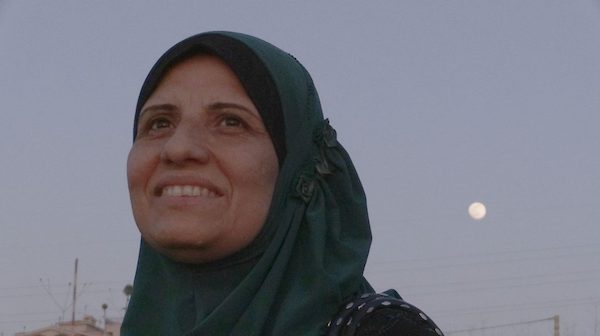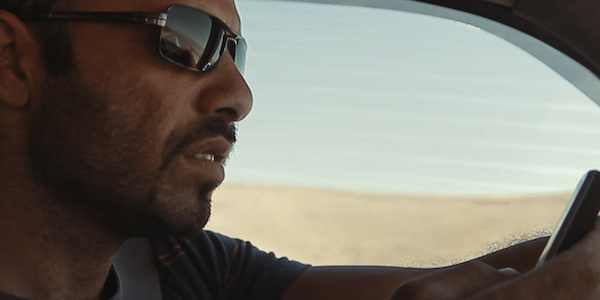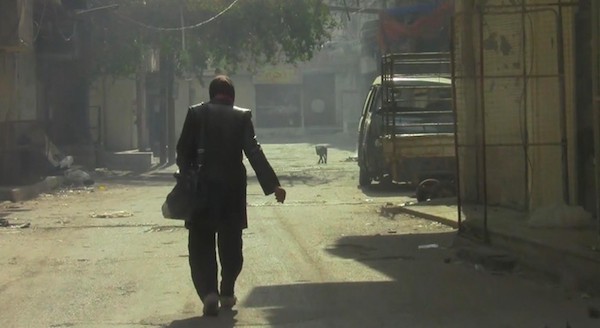Doc Talk: Tales of Exile and Return, Loss and Recovery in the Boston Palestine Film Festival
By Peter Keough
A gathering of documentaries (not to mention features and shorts) whose exploration of the perseverance of longing and identity in the wake of a historical tragedy demand to be seen.
The Fall offers a rich harvest of film festivals, so many that some can get lost in the course of the season. The Boston Palestine Film Festival (October 14-23) is one such, and this year it again boasts documentaries (not to mention features and shorts) that demand to be seen and which are as poetic in style and sensibility as they are urgent and troubling in content.

A scene from Fadia’s Tree, screening at the Boston Palestine Film Festival.
Ruins and desolation recur as motifs in films such as Sarah Beddington’s Fadia’s Tree (2021; it can be seen online here October 14-23). A Palestinian refugee living in the Bourj el-Barajneh refugee camp in Beirut, Lebanon, Fadia met the filmmaker by chance 15 years ago and asked her if she could track down the ancient mulberry that, according to family lore, grew outside her grandfather’s home in Israel. Her grandfather and her family had been expelled from their village, Sa’Sa,’ back in 1948 when the state of Israel was established. Fadia has never been there herself. She suspects that the house and the rest of the village are gone but hopes the tree has survived. At any rate, it lives in her imagination as a link with her origins. The tree is her connection with the Palestinian people and her dream is to have its existence confirmed. Beddington agrees to search for it when she can.
The promise forges a lasting friendship, but actually fulfilling the quest proves frustrating. During one attempt to find the tree Fadia tries to guide Beddington by cell phone, a mission that takes on a fairy tale quality when the filmmaker bumps into a pair of men carrying a large, two-headed plaster dragon. She asks them for directions, but to no avail, finding only rubble and scattered stones where there once might have been homes. Over the years and between searches Beddington visits Fadia at the camp, where she runs a kindergarten for the children living there. The neighborhood is a rabbit warren of twisting alleyways festooned with bundles of telephone and other wires that provide connection with the outside world.
Some of the inhabitants keep homing pigeons who, unlike, the residents, are free to travel. But, as the ornithologists Beddington interviews point out (in digressions that prove thematically integral), the hundreds of miles of containment walls that the Israeli government has put up to isolate the Palestinian population have also disrupted the migration patterns of the scores of species that cross the region every year. Meditative, punctuated with striking images, Beddington’s film captures the passage of time and the perseverance of longing and identity in the wake of a historical tragedy.

A scene from The Devil’s Drivers, screening at the Boston Palestine Film Festival.
Taking a more assertive approach to the strictures of isolation are the cousins in Mohammed Abugeth and Daniel Carsenty’s fraught and frustrating The Devil’s Drivers (2021; screens October 16 at 3 p.m. at the Museum of Fine Arts and can be seen online here October 14-23). With no work available in the Palestinian Territories where they live, and unable to get a permit to work in Israel, cousins Hamouda and Ismail decide to make money by smuggling other Palestinians seeking work across the border.
It is not an occupation for the faint of heart as the film’s Mad Max-like sequences of the pair tearing across the desert in sedans pursued by soldiers in jeeps testify. Getting caught can mean loss of money, property, and freedom, especially after a couple of illegal border crossers pull off a deadly terrorist attack. Nor is it easy on villagers caught between their inclination to help the smugglers and the pressure from the military to collaborate in catching them. A bearded patriarch, seen tending his herd in an image of pastoral serenity, will have his dwelling along with those of others razed for not cooperating with the authorities.
Filmed like Fadia’s Tree over the course of several years, The Devil’s Drivers presents a history of the ongoing regional strife from a unique perspective while filling in the broader context of failed peace initiatives, the Rabin assassination, and three intifadas with eloquently simple animation. The ordeal ends more happily for some than others, but the future prospects look grim.

A scene from Rashid Masharawi’s Recovery, screening at the Boston Palestine Film Festival.
Rashid Masharawi’s Recovery (2021; it can be seen online here October 14-23), opens with what seems like a typo in the subtitled translation. “I met Taher Al-Qalyubi six months after he had died,” the filmmaker says in voiceover. “I got to know him very well and we became very close.”
Six months after he died? Indeed. Masharawi had come across Qalyubi’s albums of photos and other memorabilia recalling the once vibrant Palestinian community in the city of Jaffa, which was then the commercial and cultural hub of Palestine, where he had grown up. It is similar in its longing mood — though different in structure — from another exquisite film about the city, Mais Darwazah’s 2013 memoir My Love Awaits Me by the Sea. The items in the collection, which also includes a VHS tape of Masharawi reminiscing about the past, span the period from 1930 until 1948 when the state of Israel annexed the city into Tel Aviv and many of the Palestinian residents were expelled. Among those exiled was Masharawi’s own father. In Qalyubi’s cache of memory, then, Masharawi seeks to recover his own past. It is his version of Fadia’s mulberry tree.
Already enriched by this context, the film is further brought to life by Masharawi’s meticulous sound design as still photos of waves hitting the shore, of crowds swarming beaches, marketplaces, cinemas, newsstands, and coffee shops, are backed by the hubbub of voices, the crash of surf, and the strains of traditional and popular music. As he listens to Qalyubi recall his experiences going to the movies and sporting events or joining student organizations demanding rights for Palestinians from the British, the then ruling power, Masharawi wonders if Qalyubi might have encountered his father during this time, if his father’s face might be found among the bustling crowds in his photos.

A scene from Abdallah Al-Khatib’s Little Palestine (Diary of a Siege), screening at the Boston Palestine Film Festival.
Abdallah Al-Khatib’s Little Palestine (Diary of a Siege) (2021; screens at the Museum of Fine Arts on October 15 at 11 a.m.; it can be seen online here October 14-23) opens with an image that might have been found in one of Qalyubi’s photo albums. A thoroughfare in a vibrant urban area, crammed with shops, sidewalk vendors, and cafes, and thronged with people. A cut is made to the same street some time later: it is a cavern of ruins, empty. A giant, ramshackle barrier blocks it off into the deadest of dead ends.
This is the “Little Palestine” of the title, the district of Yarmouk in Damascus, Syria, which sheltered the biggest Palestinian refugee camp in the world from 1957 to 2018. Until the civil war against Syrian President Bashir al-Assad broke out in 2011 it had been a thriving community. An old woman recalls how welcoming and helpful the Syrians had been to their Palestinian guests. But Assad saw Yarmouk as a rebel enclave and sealed it up, cutting it off from food and medical supplies and subjecting it to constant bombardment.
Many left. Some stayed out of defiance. Others, the elderly and children, had no choice. Al-Khatib’s mother, a nurse, stayed to care for those left behind. Al-Khatib stayed too, accompanying her on her rounds with his camera, recording the prolonged death throes of the camp and the astonishing persistence of vitality and joy – sometimes verging on the surreal, as when a group gathers around a piano in the middle of a battered street and sing — while the siege tightens. His interludes with old people and children are especially luminous, the former as he follows his mother on her rounds visiting those too infirm to leave their beds and the latter as he chats with the kids in the neighborhood who are still smiling and delighted to be on camera. A bunch gather and tell him what they dream of. Eating sugar! Going to school! My father, the way he used to be! My brother, alive again!
In perhaps the most poignant such sequence a serene little girl forages for verbena (it’s all that’s left to eat, she says) in a rubble strewn, vacant lot. Behind her loom bombed out buildings and gunfire crackles in the distance. Al-Khatib asks her the usual questions. Does she go to school? No. What does she dream of? Food. What if a bomb landed here? Then God have mercy on our souls. Don’t you love life? Yes, but not here.
Then a shell explodes nearby. Fragments rain down and the girl looks around helpless, scared, but resigned. You realize this is an innocent child subjected to the worst that humanity can offer. The camera pans to the building just behind them where the artillery shell just struck, smoke still pouring from the gutted floors. She laughs. “Nothing to be scared of,” she says, and continues her work.
Peter Keough writes about film and other topics and has contributed to numerous publications. He had been the film editor of the Boston Phoenix from 1989 to its demise in 2013 and has edited three books on film, most recently For Kids of All Ages: The National Society of Film Critics on Children’s Movies (Rowman & Littlefield, 2019).
